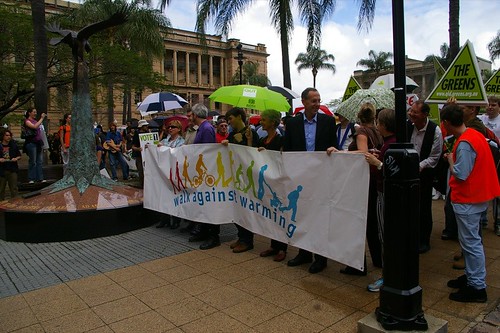November 22, 2006
From Co-op America
With the movie An Inconvenient Truth drawing record audiences last summer, and groups as diverse as the "Evangelical Climate Initiative" and the Pentagon sounding the alarm on the coming climate catastrophe, our country could be on the cusp of taking real action on a very real danger.
But how much action is enough to match the scale of the solution to the scale of the problem? Based on the data - such as rapidly melting polar icecaps - showing that climate change is happening faster than anyone had thought, it is increasingly clear: Baby steps won´t do it.
We need a bold action plan that can evaluate corporate, government, community, and household plans to reduce greenhouse gas emissions - especially carbon emissions -- to levels we can live with.
Scientists at the Princeton University´s Carbon Mitigation Initiative (CMI) have taken up this challenge, and propose stabilizing carbon emissions by dividing this huge task into smaller, doable action "wedges" of equal size-each with the capacity to reduce carbon emissions by 1 billion tons/year by 2054. CMI lists 15 possible "wedges," out of which we need to achieve just seven to reach carbon stabilization.
At my organization, Co-op America, we added our own filters to this building-block approach. We screened out measures that are too dangerous, costly, and slow (like nuclear power plants, synfuels, and "clean" coal), and we beefed up those that are safe and cost-effective. (Wind energy is cost-competitive at utility scale, and has beaten natural gas in certain markets. Solar energy will be cost-competitive within five years.)
With these filters, we developed a plan that uses current technologies; is safe, clean, and cost-effective; and is big enough to meet the climate challenge-12 "wedges" when we only need seven. Each of the following could reduce carbon emissions by at least 1 billion tons per year by 2054:
Here´s our 12-step plan:
- Increase fuel economy for the world´s 2 billion cars from an average of 30 mpg to 60 mpg.
- Cut back on driving. Decrease car travel for 2 billion 30-mpg cars from 10,000 to 5,000 miles per year, through increased use of mass transit, telecommuting, and walking and biking.
- Increase energy efficiency by one-quarter in existing buildings and appliances. Move to zero-emissions plans for new buildings.
- Decrease tropical deforestation to zero, and double the rate of new tree plantings.
- Stop soil erosion. Apply "conservation tillage" techniques to cropland at 10 times the current usage. Encourage local, organic agriculture.
- Increase wind power. Add 3 million 1-megawatt windmills, 75 times the current capacity.
- Push hard for solar power. Add 3,000 gigawatt-peak solar photovoltaic, 1,000 times current capacity.
- Increase efficiency of coal plants from an average of 32 percent efficiency to 60 percent, and shut down plants that don´t meet the standard. No net new coal plants; for new plants built, an equal number should close.
- Replace 1,400 gigawatts of coal with natural gas, a four-fold increase in natural gas usage over current levels - a short-term step until zero-emissions renewable technologies can replace natural gas.
- Sequester carbon dioxide at existing coal plants. Sequestration involves storing carbon dioxide underground, an unproven technology that may, nonetheless, be better than nothing.
- Develop zero-emissions vehicles, including plug-in hybrids and electric vehicles powered by renewable energy.
- Develop biomass as a short-term replacement for fossil fuel until better carbon-free technologies are developed - but only biofuels made from waste, and made without displacing farmland and rainforests.
This framework can help us think big and fast enough to avoid the worst consequences of climate change. If we are to achieve each wedge by 2054, the next 10 years must see major action. Anything less and we´re kidding ourselves.
The good news? We can do this. We have the technologies and the know-how. We can take many of these steps today, on our own. For the rest, we need to persuade our elected officials, contact our power companies and auto manufacturers, and demand action from those with decision-making power. The best news? Beating climate change opens the door to more jobs, energy security, progress against poverty, a cleaner environment, and a safer world - a better future for all of us.
-Alisa Gravitz





No comments:
Post a Comment